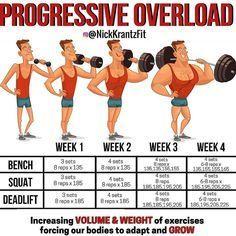In the intricate tapestry of human physiology, muscle growth emerges as a captivating phenomenon, driven by a blend of biology, dedication, and strategy. At the heart of this transformative journey lies a principle as deceptively simple as it is profoundly effective: progressive overload. This cornerstone of strength training is akin to a master key, unlocking the potential for muscular development by systematically challenging the body to adapt to ever-increasing demands. As we delve into the role of progressive overload in muscle growth, we unravel the science behind this method and explore how it shapes the contours of our strength and endurance. Join us as we embark on an exploration of how incremental challenges forge the path to greater physical prowess, illuminating the delicate balance between effort and adaptation.
Unlocking the Science Behind Progressive Overload for Optimal Muscle Gain
At the heart of effective strength training lies the principle of progressive overload, a fundamental concept that drives the journey from novice lifter to seasoned athlete. This method involves gradually increasing the amount of stress placed on the body during exercise, compelling muscles to adapt, grow, and strengthen over time. Whether it’s adding more weight, increasing repetitions, or enhancing workout intensity, each adjustment contributes to this dynamic process. The human body is remarkably adaptable, and by consistently challenging it beyond its current capabilities, progressive overload ensures that muscle fibers are broken down and rebuilt stronger, leading to substantial muscle growth.
Incorporating progressive overload into a training regimen can be approached through various strategies, including:
- Volume Increase: Gradually adding more sets or reps to your routine.
- Intensity Boost: Lifting heavier weights as your strength improves.
- Frequency Adjustment: Increasing the number of workouts per week.
- Time Under Tension: Slowing down the tempo of your lifts to increase muscle engagement.
By systematically implementing these strategies, athletes can avoid plateaus and continue making progress, ensuring that each workout session is a step closer to achieving their muscle-building goals.

Strategic Techniques to Implement Progressive Overload in Your Workout Routine
Incorporating strategic techniques into your workout routine is crucial for effectively implementing progressive overload, ensuring continuous muscle growth and strength development. Here are some practical approaches to keep your muscles challenged and engaged:
- Increase Weight Gradually: One of the most straightforward methods is to incrementally add weight to your exercises. By doing so, you compel your muscles to adapt to the new demands, fostering growth.
- Adjust Repetitions and Sets: Tweaking the number of reps and sets can also introduce new challenges. Try adding a set or increasing the reps while maintaining the same weight to enhance endurance and stimulate muscle fibers differently.
- Enhance Time Under Tension: Slowing down the eccentric (lowering) phase of your lifts increases the time your muscles are under tension, promoting greater muscle breakdown and subsequent growth.
- Incorporate Advanced Techniques: Techniques like drop sets, supersets, or pyramid sets can shock your muscles, forcing them to adapt and grow by varying the intensity and volume within your workout.
- Vary Your Exercises: Regularly introducing new exercises can prevent plateaus and ensure that different muscle groups are targeted, fostering a balanced and comprehensive growth.
By employing these strategic techniques, you ensure a robust and dynamic approach to progressive overload, paving the way for consistent and sustainable muscle growth.

Avoiding Common Pitfalls: Ensuring Safe and Effective Muscle Growth
Embarking on a journey to build muscle is thrilling, yet it’s crucial to sidestep common mistakes that can hinder progress. A significant blunder many make is ignoring the principle of progressive overload. This concept, while simple, is a cornerstone of effective muscle growth. It involves gradually increasing the demands placed on your muscles, prompting them to adapt and grow stronger. Without this gradual increase, your body has no reason to grow, often leading to stagnation.
To implement progressive overload safely and effectively, consider the following strategies:
- Increase Resistance: Gradually add more weight to your exercises to challenge your muscles.
- Boost Repetitions: Once comfortable with a weight, increase the number of reps to push your limits.
- Enhance Volume: Add more sets to your routine to increase overall workout volume.
- Shorten Rest Intervals: Decrease the rest time between sets to intensify the workout.
- Focus on Form: Ensure each movement is performed with proper form to avoid injury and maximize efficiency.
By incorporating these strategies thoughtfully, you can achieve steady muscle growth while minimizing the risk of injury, ensuring your efforts are both safe and effective.

Tailoring Progressive Overload to Individual Fitness Goals and Needs
Progressive overload is a cornerstone of effective training, yet its application is far from one-size-fits-all. Tailoring this principle to individual fitness goals and needs is crucial for optimizing results. Understanding personal objectives—whether it’s increasing strength, enhancing endurance, or building muscle mass—is the first step in crafting a customized approach. For instance, someone aiming for hypertrophy might focus on gradually increasing the weight lifted, while an endurance athlete might prioritize adding more repetitions or sets. Each approach ensures that the body is continually challenged in a way that aligns with specific goals.
Customization doesn’t stop at goals; it also considers personal circumstances. Factors to consider include:
- Current fitness level
- Recovery ability
- Availability of equipment
- Time constraints
Integrating these elements into a progressive overload strategy not only makes the regimen more effective but also sustainable. By doing so, individuals can avoid the pitfalls of overtraining and maximize their potential for growth and improvement.
